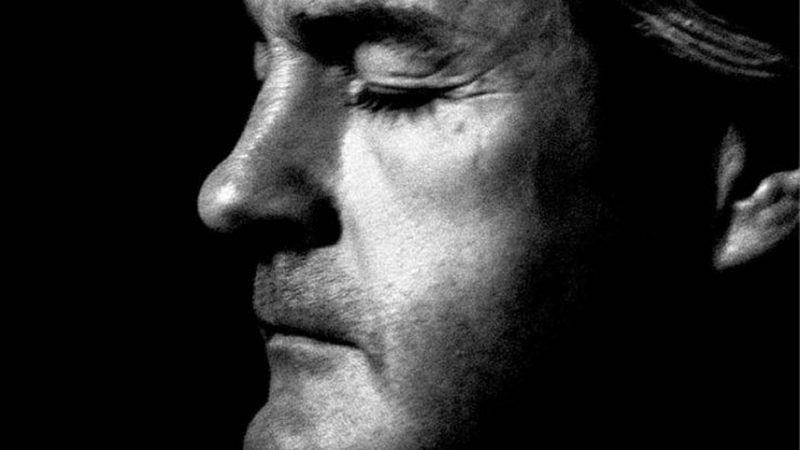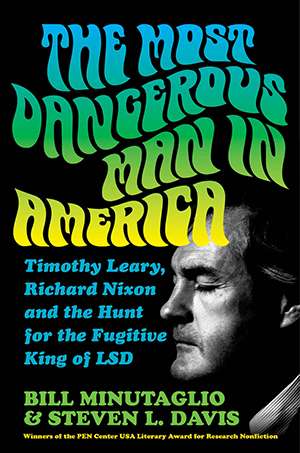1972: The Year That Made 2018 Seem Sane
Richard Nixon's battle with Timothy Leary puts today's culture wars to shame.

The Most Dangerous Man in America: Timothy Leary, Richard Nixon and the Hunt for the Fugitive King of LSD, by Bill Minutaglio and Steven L. Davis, Twelve Books, 384 pages, $30

The early 1970s were a strange, chaotic, terrifying time. Exactly how strange, chaotic, and terrifying has been largely forgotten, to judge from how many Americans on both sides of the Donald Trump divide view our current tensions as unprecedentedly intense.
Journalist-historians Bill Minutaglio and Steven L. Davis are not deliberately trying to deliver a message about historical perspective. But in their thrilling The Most Dangerous Man in America: Timothy Leary, Richard Nixon and the Hunt for the Fugitive King of LSD, they show how bad things got in a nation truly troubled by vicious culture wars, wracked by violent ideological conflict, and ruled by a near-lunatic abusing his power to pursue personal and political grudges.
Timothy Leary was a Harvard professor–turned–psychedelic advocate, a leader of the "head" faction that was rebelling against the establishment. He had been a voice for personal liberation and for "dropping out" of a stultifying culture, not a politically motivated leftist revolutionary. The U.S. government helped change that.
The war on the troublemaking psychologist is in progress as the book's narrative begins in May 1970. Leary, who had received a maximum sentence of 10 years for being caught with two charred marijuana roaches, is being shipped to a minimum security prison in San Luis Obispo, California.
After serving fewer than four months in that prison, the 49-year-old academic managed to clamber over the fence via a telephone wire. His next moves were intimately entwined with two different American revolutionary armies operating at the time. One, the Weather Underground, provided Leary with a getaway car, safe houses, and help with the fake passport that allowed him (and his wife Rosemary) to flee the country by plane. The Learys, as the Weather Underground directed them, then hooked up with the other revolutionary force—becoming guests of the Black Panthers' government-in-exile run by Eldridge Cleaver in Algeria.
FBI Director J. Edgar Hoover swore Leary wouldn't last in the wild for more than 10 days. But Leary's post-escape trip rolled on for more than two years and shadowed the crackup of the Nixon administration.
The book's greatest fun is the tense and comic-absurd description of the intractably hedonistic Leary aggravating Cleaver with his lack of revolutionary discipline. Cleaver wanted Leary to study up on Mao and Kim Il Sung; Leary preferred tripping on acid in the desert. (The Weather Underground did successfully pressure Leary into issuing calls for violent revolution, an idea he'd never advocated before and disavowed later.) The psychologist eventually found himself the victim of what became known in the underground press as a "revolutionary bust": Cleaver had the Learys kidnapped from their apartment and held captive, because he felt Tim's recklessness was "jeopardiz[ing] our work toward revolution in Babylon."
During Leary's Algerian captivity, the FBI, in an effort to break up the Black Panther Party, began taunting Cleaver and the U.S.-based Panther leader Huey Newton with invented accounts of the terrible things they were supposedly saying about each other. This added to the atmosphere of paranoia.
President Richard Nixon, in a classic tragicomedy, created the conditions that long foiled his Leary manhunt. More than one foreign government refused to help the hated Nixon on general principle. The more obviously desperate he became to nab Leary, the less cooperative they wanted to be.
In Switzerland, where Leary spent 1972 after slipping out of the Panthers' grip in Algeria, the government noted that Leary's initial pot crime would have been at worst a ticket for him there. International intellectual pressure convinced the Swiss that Leary qualified as a political refugee, not a mere grubby drug criminal. They booted him by the end of 1972, but they still refused to deliver him to Nixon.
The book is structured so that details of Leary's wild exile alternate with Nixon's descent into paranoid mania and what would in any nonpolitical context be horrific fits of mass murder, such as the "Christmas bombings" of Vietnam. A tantalizing possibility may arise in the reader's mind: Perhaps, if not for Timothy Leary, the president might not have behaved in a way that led to Watergate and his eventual resignation.
Nixon did begin to seriously consider procuring a private squad of intelligence goons a couple of months before Leary escaped. (That specific plan was shot down by Hoover, of all people.) But G. Gordon Liddy, one of the euphemistically named "White House Plumbers" Nixon eventually dispatched anyway, came to the president's attention because of his role in an earlier arrest of Leary in New York. Nixon's growing preoccupation with surveilling and crushing his enemies grew in lockstep with his mania to capture this man who dared suggest that psychedelics could offer a desirable experience. Such counterfactuals are impossible to prove, but Leary obsessed Nixon, who saw the roving trickster running free as a synecdoche for the population of hippies, yippies, and druggies he perceived as being at literal war with America.
For those contemplating exactly how out of control America was then compared to now, the most pertinent evidence is the book's compendium of a near-constant series of terror bombings.
The authors describe explosions in New York at National Guard headquarters, police headquarters, and three Manhattan banks; bombings in San Francisco's Presidio and at a church during a police officer's funeral; Molotov cocktails tossed in Wisconsin city halls and Connecticut ROTC offices; post offices, courthouses, and draft boards lit up across the country; 81 sticks of dynamite found at a Kansas university; and rocks, bottles, and eggs tossed directly at Nixon and California Gov. Ronald Reagan.
According to Bryan Burrough's 2015 book Days of Rage (Penguin Press), the U.S. suffered nearly five bombings every day during one 18-month period in 1971–72. Hijackings had become so common—33 in 1969 alone—that the president's family was barred from flying commercial.
Leary's overseas spree (where he found himself continually squeezed as a cash cow by those he relied on) dovetailed with America's cultural and political chaos. By January 1973, when the feds decided they weren't going to let aggravating legal niceties hold them back and just kidnapped him in Afghanistan, the violence that had inspired Nixon to prioritize his capture was winding down.
But for a while there, it was bad. The modern American populace would likely die of head-exploding embolisms if even a quarter of that sort of madness were common today.
It's not just the violent backdrop that casts the present in a surprisingly sane light. It's the war on Leary itself.
Leary had technically been jailed for pot. But Nixon labeled him "the most dangerous man in America" and let the pursuit of him waste the time of many of the government's highest officials. (Attorney General John Mitchell was sent on a mission, kept secret from the press at the time, to personally convince the Swiss to hand the fugitive over.) All this because of Leary's countercultural support for a hyperindividualist embrace of personal experiential liberation.
In a July 1971 White House meeting, Treasury Secretary John Connally suggested it would be easier to counter those ideas if the administration could identify a single "drug enemy." He mentioned "the guy who went to Algeria."
"Leary, Leary, Leary…Timothy Leary, Timothy Leary!" Nixon and his aides began shouting, according to Minutaglio and Davis. "Well, we've got room in the prisons for him!" Nixon declared.
Imagine if the actress Rose McGowan—a contemporary leader in the #MeToo movement who is currently facing cocaine charges—fled the country. As tortured as our current culture wars can be, it's thankfully hard to imagine Trump marshalling the forces of America's diplomatic, intelligence, and crime-fighting apparatus to nab someone merely for the symbolism.
Nixon's quest for Leary was not about crime and justice. It was a vicious rearguard war against cultural change. One Weather Underground member, the authors report, spun a fantasy for Rosemary Leary before she fled America with her husband, of a world where "Nixon will be overthrown.…The draft will be abolished, the war will end, and pot and LSD will be legalized." What a wild, glorious future.
This article originally appeared in print under the headline "1972: The Year That Made 2018 Seem Sane."




Show Comments (53)